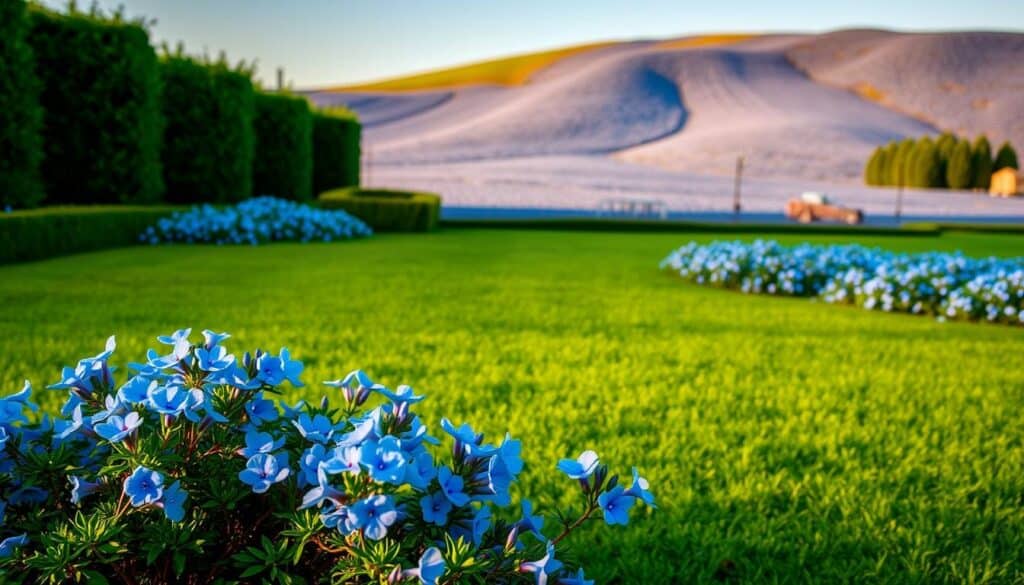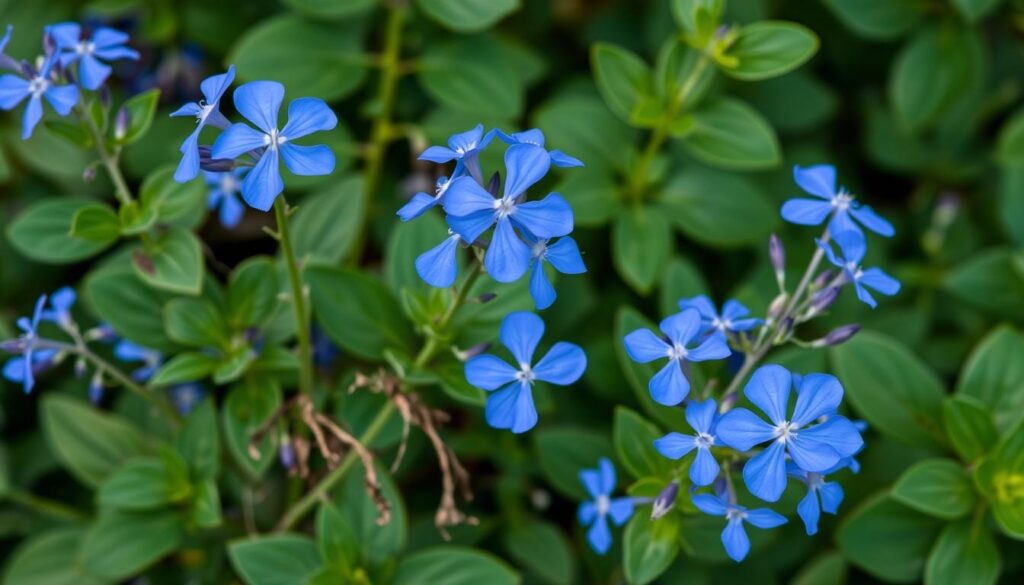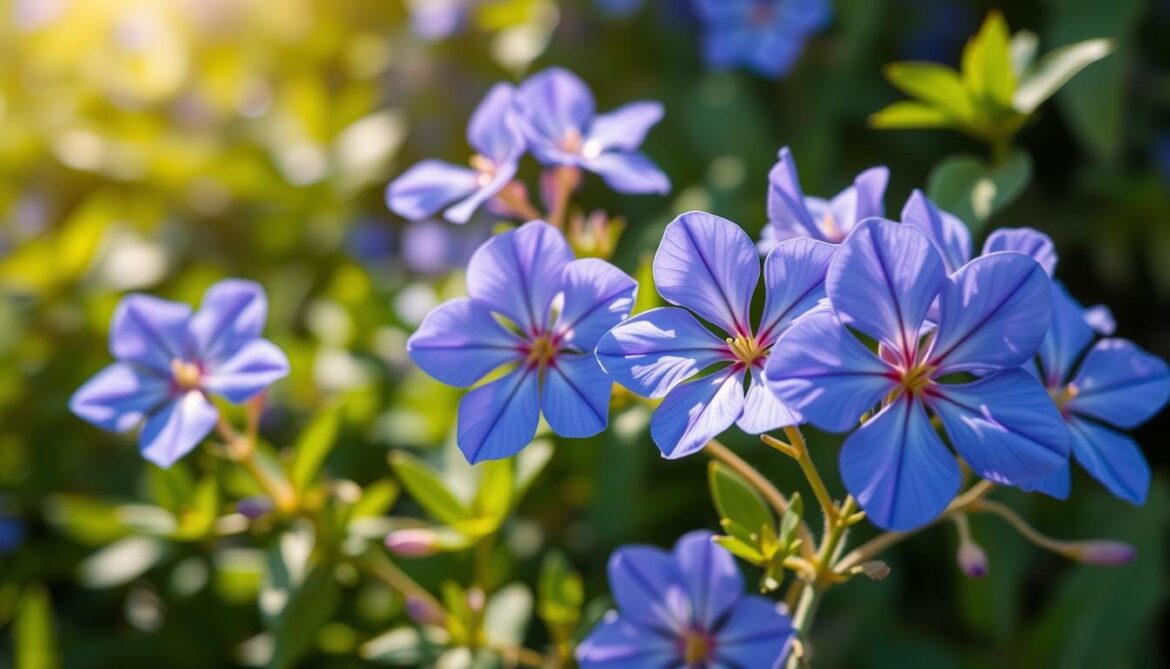Imagine walking into a garden filled with sky-blue flowers against green leaves. That’s what blue plumbago brings to any space. It’s perfect for both experienced gardeners and beginners. Its bold color and easy care make it a favorite.
Blue plumbago fits well in many places, from sunny patios to big gardens. It adds beauty all year round.
This plant’s story is not just about looks. It’s also about being tough. Coming from South Africa, it thrives in gardens across America. It doesn’t need much care to look great.
Blue plumbago is great for attracting butterflies and filling empty spots. Let’s see why it’s a favorite in gardens and parks.
Key Takeaways
- Blue plumbago’s vibrant blooms add instant color to any garden.
- It grows well in USDA zones 8-11, adapting to different climates.
- Low maintenance care keeps this plant thriving with minimal effort.
- Attracts pollinators like bees and butterflies.
- Works in borders, containers, or as ground cover.
Introduction to Blue Plumbago
The blue plumbago plant comes from South Africa. It’s loved for its bright blue flowers and how easy it is to care for. This evergreen shrub is perfect for gardens, adding color to both borders and containers.
What is Blue Plumbago?
The scientific name for this plant is Plumbago auriculata. It’s part of the Plumbaginaceae family. It blooms with star-shaped flowers all year in zones 9-11. It’s known for:
- Leathery, dark green leaves
- Fast growth rate (3-5 feet in one season)
- It can handle heat and drought well
Common Names and Varieties
People also call it Cape Plumbago, Sky Flower, and Cape Leadwort. These names highlight its beauty and adaptability.
| Common Name | Botanical Name | Key Traits |
|---|---|---|
| Cape Plumbago | Plumbago auriculata | Native to Cape Province regions |
| Sky Flower | Plumbago auriculata | Flowers resemble sky blue hues |
| Cape Leadwort | Plumbago auriculata | Alternate name in horticultural trade |
Garden centers have special varieties like Blue Wonder and Wedgewood Blue. These offer different heights and colors for your garden.
Botanical Characteristics of Blue Plumbago
Knowing the blue plumbago plant’s traits helps gardeners choose the right spot for it. This section covers its classification, unique features, and how it grows. It makes growing blue plumbago easier and more confident.
Scientific Classification
The Plumbago auriculata is a flowering shrub in the Plumbaginaceae family. It comes from South Africa. It’s different from the leadwort plant in its flowers and leaves.
Distinctive Features
- Flowers: Sky-blue, star-shaped blooms cluster together. They bloom from spring to fall.
- Leaves: The leaves are dark green, glossy, and smooth. They add interest all year.
- Seeds: Small, sticky seed capsules form after the flowers. They help the plant spread naturally.
Size and Growth Habit
| Feature | Description |
|---|---|
| Height | 3–10 feet tall, depending on pruning |
| Spread | 3–10 feet wide, forming a dense shrub or vine |
| Growth Pattern | Sprawling stems can trail or climb with support |
Its flexible growth makes it great as a groundcover, trellis climber, or shaped shrub. Regular pruning keeps it the right size for growing blue plumbago in different landscapes.
Ideal Growing Conditions
Learning to grow blue plumbago begins with knowing its basic needs. The key to good blue plumbago care is soil, light, and water. By adjusting these, you’ll get beautiful blooms and strong growth.
Soil Requirements
- Soil that drains well is essential to avoid root rot. Sandy or loamy soils are best.
- The ideal pH is 6.0–7.0. It can handle slightly acidic or alkaline soils too.
- If your soil is heavy clay, add compost to make it drain better.
Light Preferences
- Soil that drains well is essential to avoid root rot. Sandy or loamy soils are best.
- The ideal pH is 6.0–7.0. It can handle slightly acidic or alkaline soils too.
- If your soil is heavy clay, add compost to make it drain better.
Light Preferences
For the best blooms, plant in spots with 6–8 hours of sunlight daily. If it’s very hot, some shade is okay. But less light means fewer flowers. A south-facing garden is perfect.
Watering Needs
New plants need water every week until they’re settled. Once grown, they can handle some drought. But they do better with deep water every 2–3 weeks. Make sure the soil isn’t too wet. For tips on keeping the right moisture, check out seasonal watering methods for veggies.
Planting Blue Plumbago

Learning the basics of planting is key for your blue plumbago plant to flourish. Follow these steps to create a strong base for this lively shrub.
Best Time to Plant
In most U.S. areas, spring or early fall is the best time to plant. For USDA zones 8-10, late winter is ideal. Make sure to avoid planting in extreme heat or frost. The best planting temperatures are between 60-75°F.
How to Plant Blue Plumbago
Start by preparing the soil as mentioned earlier. Dig a hole that’s twice as wide and as deep as the root ball. Place the plant so the root ball’s top is even with the soil surface. Fill in with native soil, pressing gently around the roots. Water well after planting to remove air pockets.
Spacing Guidelines
Here are some spacing tips based on your landscaping needs:
| Landscaping Use | Spacing |
|---|---|
| Individual specimens | 3–4 feet apart |
| Hedges | 2–3 feet between plants |
| Ground cover | 1–2 feet spacing |
Proper spacing helps with airflow and growth. Mulch around the plants to keep moisture in and weeds out.
Caring for Blue Plumbago
To keep blue plumbago healthy, follow blue plumbago care tips. Regular blue plumbago pruning and pest control help plants grow strong and bloom brightly. Here’s how to care for your plants.
Fertilization Tips
Start with a 10-10-10 slow-release fertilizer in early spring and midsummer. Use ½ cup per plant, spreading it evenly around the base. For organic choices, compost or fish emulsion every six weeks during growth.
- Apply fertilizer 6 inches away from the stem to avoid root burn.
- Avoid over-fertilizing to prevent foliage burn.
Pruning Techniques
Prune annually to keep shape and encourage blooms. For blue plumbago pruning:
- Trim dead stems right after blooms fade.
- Hard prune in late winter to refresh overgrown plants.
- Use clean shears to cut stems to 12 inches tall for a new start.
Pest and Disease Management
| Issue | Signs | Solution |
|---|---|---|
| Spider Mites | Yellow speckles on leaves | Weekly neem oil sprays |
| Whiteflies | Wilted leaves with sticky residue | Insecticidal soap applications |
| Powdery Mildew | White fungal coating | Sulfur-based fungicide sprays |
Keep plants apart for better air flow. Also, avoid wet leaves at night to prevent pests.
Blue Plumbago in Landscaping

Blue plumbago is great for any garden. It’s a hardy shrub that adds color and structure all year. It fits well in many settings.
As a Ground Cover
Blue plumbago is perfect for covering slopes or empty spots. Its stems spread out, making a thick mat that stops weeds. Tips:
- Plant 3-4 feet apart for full coverage within one growing season.
- Mow lightly after bloom to encourage new growth.
Container Gardening
Here’s how to grow blue plumbago in pots:
- Choose containers at least 12 inches wide with holes for drainage.
- Use a mix of well-draining potting mix and compost.
- Water deeply when the soil is 1 inch dry.
Accents in Mixed Borders
| Plant Pairing | Benefits |
|---|---|
| Salvias | Contrasting spikes highlight blue plumbago’s flowers |
| Ornamental grasses | Create textural contrast in wind-prone areas |
| Rose bushes | Soft blue blooms complement bold rose colors |
Place clusters of 3-5 plants for the best look. Cut off spent blooms to keep flowers coming. This blue plumbago does well in USDA zones 8-11 with sun-loving friends.
Popular Varieties of Blue Plumbago
Choosing the right blue plumbago plant variety is key for a vibrant garden. Discover the top picks for different gardening needs.
Cape Plumbago
Cape Plumbago (Plumbago auriculata) is famous for its sky-blue flowers and sprawling growth. It grows 10–15 feet tall, perfect for hedges or screens. Its flowers bloom all year, making your garden beautiful always.
Blue Wonder Plumbago
Blue Wonder Plumbago is compact, reaching 3–4 feet tall. It’s great for small gardens or containers, with true-blue flowers. It’s ideal for modern, urban gardens.
Other Noteworthy Cultivars
- Royal Cape: Its deep violet-blue flowers stand out against green leaves.
- Alba: This rare variety has white flowers, adding a unique touch to borders.
- New hybrids like Plumbago ‘Compacta’ are drought-resistant and smaller.
Garden centers now carry these special varieties. They meet various needs for color, size, and climate. Visit local nurseries for the best options for your area.
Propagating Blue Plumbago

Expand your garden effortlessly with blue plumbago propagation. Two key methods—seed and vegetative techniques—offer flexibility for multiplying these vibrant shrubs.
Seed Propagation
Collect seeds after flowers fade, storing them in a sealed envelope in a cool, dry spot. Sow seeds indoors 6-8 weeks before last frost. Germination takes 2-3 weeks. Note: Seed-grown plants may vary from parent plants, making this method ideal for experimenting with new growing blue plumbago variations.
Cuttings and Division
For consistent results, take 4-6″ stem cuttings in spring or early summer. Strip lower leaves and dip cut ends in rooting hormone. Plant in moist soil mix. Divide overgrown clumps every 3-5 years by carefully splitting roots into sections with healthy shoots. Both methods ensure new plants retain parent traits.
Best Practices
- Time cuttings and divisions during active growth periods (spring/summer).
- Use well-draining soil to prevent root rot during blue plumbago propagation.
- Cover cuttings with a plastic dome to maintain humidity until roots form.
Check for root development after 4-6 weeks by gently tugging the stem. Water sparingly until new growth appears.
Blue Plumbago and Wildlife
The blue plumbago plant is more than just beautiful flowers. It’s a key player in local ecosystems. It’s a favorite among gardeners who care about the environment.
Attracting Pollinators
The blue flowers of the blue plumbago plant attract many pollinators. Butterflies, bees, and hummingbirds love the nectar. Gardeners who use blue plumbago landscape uses see more insects.
- It blooms all spring and summer, providing food.
- Its flower clusters are easy for many pollinators to reach.
- It helps keep biodiversity in cities and suburbs.
Benefits to Local Ecosystems
The blue plumbago plant does more than just attract pollinators. It helps ecosystems in many ways. Its long blooming season fills gaps in nectar availability.
Its dense leaves offer shelter for insects and small animals. Even in cities, it helps wildlife corridors. Conservation groups suggest it for restoring habitats. Using blue plumbago landscape uses in gardens supports local wildlife and adds beauty.
It’s easy to care for and has a big impact on the environment. It attracts beneficial insects and birds, helping with pest control and balance in ecosystems.
Seasonal Care for Blue Plumbago

Seasonal changes require specific care for blue plumbago to stay vibrant all year. Whether in the ground or in containers, adjusting care for winter and spring is key. This ensures steady blooms and keeps the plants hardy. Follow these steps for thriving plants in all zones.
Winter Care Techniques
In colder zones 7-8, protect plants from frost with these methods:
- Apply 3-4″ mulch layer around roots to retain warmth
- Move potted specimens indoors or to sheltered porches below 32°F
- Inspect stems after freezes – prune dead wood in early spring
For more detailed steps, check out this blue plumbago care guide for zone-specific tips.
Spring Growth Strategies
Restart growth with these spring actions:
- Prune frost-damaged branches to stimulate new shoots
- Fertilize with balanced 10-10-10 mix as buds appear
- Water deeply but allow soil to dry between sessions
Watch for early signs of disease. Proactive checks can prevent issues like those in fruit trees, as outlined in this disease management guide.
Adjust your techniques based on your local climate. Southern areas might not need winter prep, while northern growers should add extra frost guards. Regular monitoring keeps blue plumbago resilient through all seasons.
Common Problems with Blue Plumbago
Blue plumbago needs careful care to avoid common problems. Too much water can cause root rot and yellow leaves. Make sure the soil drains well and water less often. Pruning dead stems yearly also keeps the plant healthy.
Overwatering Issues
Too much water shows as soggy soil and wilted leaves. To fix:
- Check soil moisture before watering
- Improve drainage with gravel or raised beds
- Reduce watering frequency in winter
Leaf Drop Causes
Leaf loss can come from:
| Problem | Solution |
|---|---|
| Environmental stress | Adjust watering and mulch roots |
| Pest damage | Inspect for insects and treat early |
| Seasonal changes | Accept natural shedding in fall |
Solutions for Pest Infestations
Spider mites and scale insects harm plants. To fight pests:
- Wipe leaves with soapy water weekly
- Use neem oil sprays for heavy infestations
- Prune affected branches quickly
For serious problems, check plant disease management guides. Regular pruning removes sick parts and boosts air flow, lowering pest risks.
Blue Plumbago in Different Climates
Blue plumbago can grow in many climates but needs special blue plumbago care to thrive. It does well in both hot and cold weather. With the right care, it stays healthy all year.

Growing in Southern Regions
In USDA zones 9–11, blue plumbago is a hardy perennial. It needs regular water and well-drained soil to avoid root rot. Prune it hard in spring to keep it in check.
Watch out for spider mites in dry areas. Use insecticidal soap to treat them.
- Prune twice yearly to maintain shape.
- Apply 2–3 inches of mulch in summer for moisture retention.
- Plant in full sun for best flowering.
Adapting to Northern States
In colder zones (5–8), treat blue plumbago as an annual or grow it in containers. Move plants indoors in winter for a sunny spot. For outdoor beds, mulch heavily in fall to protect roots from frost.
- Container plants need winter shelter in unheated garages.
- Cut back foliage before moving indoors to reduce pest risks.
Adjusting care like mulching or using containers helps gardeners everywhere enjoy its vibrant blooms. For more ideas, check out purple flower varieties that do well in similar conditions.
Gardening Tips for Success
Mastering blue plumbago landscape uses starts with smart planning. These tips ensure your plants thrive and enhance garden aesthetics.
Companion Plants
Pair blue plumbago with plants that share its sun-loving, drought-tolerant nature. Try these combos:
- Lantana – Bright yellow blooms create bold color contrasts.
- Ornamental grasses – Add texture with plants like Mondo Grass or Pennisetum.
- Sedum – Drought-resistant varieties like Sedum spurium match its care needs.
Design Ideas
- Train vines to cascade over retaining walls or fences.
- Create informal hedges by planting 3–4 ft apart.
- Use as a focal point in mixed beds with evergreen shrubs.
Using Blue Plumbago as Ground Cover
For effective ground cover, space plants 3–5 feet apart. Improve soil drainage before planting. On slopes, use mulch to retain moisture. Blue plumbago propagation via stem cuttings ensures consistent coverage in large areas. Trim regularly to fill gaps and promote dense foliage.
Conclusion: The Enduring Appeal of Blue Plumbago
Blue plumbago is a top pick for gardeners wanting vibrant, easy-to-care-for plants. Its lasting appeal comes from meeting today’s landscaping needs.
Recap of Benefits
Blue plumbago plants do well in many places, blooming from spring to fall. They are drought-resistant once they’re settled, saving water. They’re great for ground cover, pots, or borders.
They also help the environment by drawing in bees and butterflies. This supports local wildlife.
Final Thoughts on Cultivation
To grow blue plumbago well, match its care to your area’s climate. In the South, it grows all year. In the North, it’s best as an annual.
Try different types like Cape Plumbago or Blue Wonder for any garden. Prune regularly and space plants right to keep them healthy. This brings constant color to your outdoor space.
By following these tips, you can have a plant that’s both beautiful and useful. It’s a must-have for any garden.

